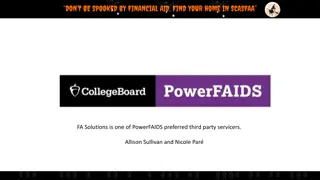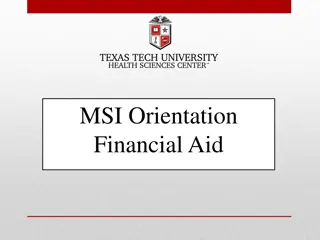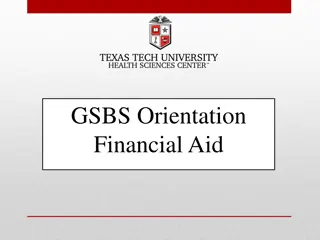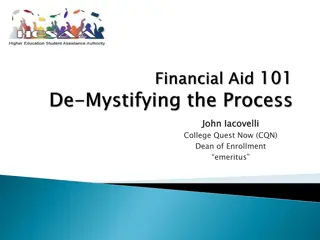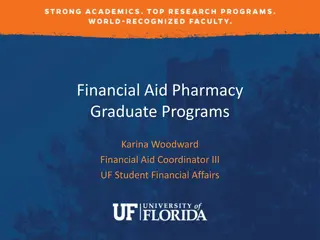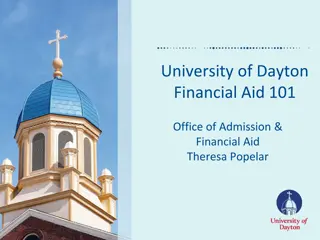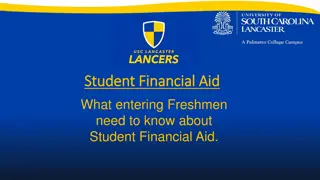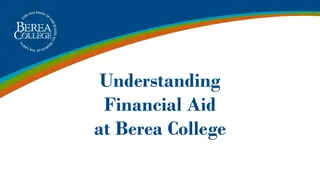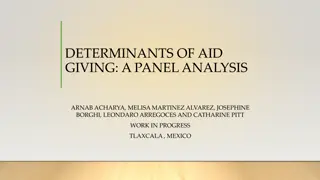Comprehensive Guide to Medical Student Financial Aid
This detailed guide covers items covered and not covered by financial aid, typical financial aid award packages, budgets for each year of study, important fourth-year considerations, and federal loan interest rates. It provides a breakdown of expenses such as tuition, fees, housing, transportation, and more, helping medical students plan their finances effectively throughout their education.
Download Presentation

Please find below an Image/Link to download the presentation.
The content on the website is provided AS IS for your information and personal use only. It may not be sold, licensed, or shared on other websites without obtaining consent from the author. Download presentation by click this link. If you encounter any issues during the download, it is possible that the publisher has removed the file from their server.
E N D
Presentation Transcript
MSIV Orientation Financial Aid
Items Covered By Financial Aid Tuition & Fees Books & Supplies (including lab equipment) Housing and food (rent, utilities, phone, groceries) Transportation (insurance, maintenance, gasoline) Health Insurance Personal and miscellaneous (medical, dental, clothing, cleaning, etc.) Travel and living expenses for away rotations (4th year only) Transportation costs for residency/job interviews (4th year only - additional documentation required) USMLE clinical skills exam Computer (budget adjustment form and proof of expense required; may only be submitted once during degree plan)
Items NOT Covered by Financial Aid Automobile payments Consumer debt (credit cards, loan payments) USMLE review courses Spouse s expenses (such as medical expenses or insurance)
First Year 10 mo Second Year 9 mo Third Year 12 mo Fourth Year 11 mo 2nd Year Fast Track 12 mo Tuition and fees Away Rotations (MSIV only) Bks/supp'ls Housing/food Transportation Personal/Misc. Step 2/Clinical Skills Loan Fees Estimated Total Budget n/a $ 18,808 $ 18,808 $ 18,808 $ 18,808 3,000 1,734 15,642 5,500 6,600 18,808 - - - 0 1,734 14,220 5,000 6,000 1,734 12,798 4,500 5,400 610 520 44,370 1,734 17,064 6,000 7,200 2,000 520 53,326 1,734 17,064 6,000 7,200 610 520 51,936 - 520 520 46,282 51,804 $ Total for 4 years = $195,782 Total for FMAT 3 years = $150,022 Financial Aid Budgets
4th Year - Important Items: Step 2/Clinical Skills tests (COA) Includes cost of test and travel to test site (in MSIII financial aid budget). Cannot include the costs of retake ERAS Electronic Residency Application Complete the budget increase Interview & Travel Away Rotations costs (COA) (might be limited due to Pandemic) Residency & Relocation Financial Planning & Debt Awareness (end of year AAMC) NSLDS access for federal loans, set it up
Typical Financial Aid Award Packages Annual Amount Loan Type MSI MSII MSIII MSIV Unsubsidized Loan $40,500 $40,500 $47,167 $44,944 Grad Plus Loan/ Alternative Loan $5,782 $3,870 $6,159 $6,860 Total $46,282 $44,370 $53,326 $51,804 Federal loan interest rates before June 30, 2020 Unsubsidized Loan: 6.08% Federal loan interest rates after July 1, 2020 Unsubsidized Loan: 4.30% Alternative Loan: Variable rates between lenders (please note, grad plus and alternative loans require credit approval) Grad Plus Loan: 7.08% Grad Plus Loan: 5.30%
Financial Planning Resource The AAMC website is an excellent resource for many of your medical school needs; both academic and financial. Some of the financial aid resources include, loan repayment calculators, budgeting and debt management. Their website is: https://students-residents.aamc.org/financial-aid/
You can locate loan servicer information and current federal loan totals on the Federal Student Aid website. https://studentaid.gov/h/ manage-loans You will need your FSA ID and password to access the information. Federal Loan Information
Mandatory Medical Residency Forbearance Loan Servicers are required (upon your request) to provide you with this forbearance for your federal student loans (excluding Perkins loans) Postpones loan payments in annual increments You must request the Medical Residency Forbearance each year Capitalization of interest may occur at end of residency Timely request of forbearance (30 days before each annual request) allows a continuous forbearance (without a gap between years) and will allow you to postpone capitalization until the end of your residency. Remember, subsidized, unsubsidized and grad plus loans will be accruing interest. For a student with approximately $180,000 of loans, the amount of monthly interest is approximately $1,100 Residency
Student Business Services Please contact Student Business Services (SBS) at (806) 743-7867 or at SBS@ttuhsc.edu for questions regarding: Tuition and fee information, tuition payment options, and payment plans How refunds are processed or how to set up direct deposit information How to submit 3rd party payment information
Office of Financial Aid Student Services Suite 2C400 TTUHSC Office of Financial Aid 3601 4th Street MS8310 Lubbock, TX 79430-8310 (806) 743.3025 phone (806) 743.2304 fax financial.aid@ttuhsc.edu Mia.C.Myers@ttuhsc.edu www.ttuhsc.edu/financial-aid Office hours: Monday-Friday 8am-5pm No appointment needed to see an advisor










